Evaluating the Applicability of Mainstream Wave Energy Converters in the South China Sea
Abstract
:1. Introduction
2. Materials and Methods
2.1. Materials
2.1.1. ERA-5 Reanalysis Wave Field Data and Buoy Data
2.1.2. Existing Wave Energy Extraction Technologies
2.2. Methods
2.2.1. Applicability Evaluation Index and Calculation Method for Each Wave Energy Con Version Device
- (1)
- Matrix normalization
- (2)
- Calculate the information carrying capacity
- (3)
- Calculate the weights
2.2.2. Determination Method of Dominant Development Areas and Key Stations
- (1)
- Sea state conditions: According to the international standard sea state scale (1–9), when the sea state is at level 6 (with wave heights of 4–6 m), the frothy crests of waves are beginning to extend into streaks along the slanting wave faces, and sometimes the wave crests take on a shape similar to that of storm waves. Although some WEC devices may be able to operate under these conditions, for the majority of WEC devices, this sea state can still cause certain damage.
- (2)
- Meeting operating conditions for the majority of WEC devices: Through researching literature and examining the design and operation of WEC devices currently available on the market, it has been found that the effective wave height for these devices to enter storm protection mode is generally between 4 and 6 m. Furthermore, when the wave height is lower, the power output of WEC devices is lower, and in some cases, they may not be able to generate any power at all [27,41,42,43,44,45].
- (1)
- The average annual , average annual , and main wave proportion of each grid point in each small study site in the four larger areas (A, B, C, and D) are calculated. Then, the average value of each index from all grid points in each small site is taken as the result of each index in this small study site.
- (2)
- The minimum and maximum annual average , annual average and of all grid points in all small study sites contained in each large area were selected, and the indices were divided into interval segments and grades. Taking the division of the annual average as an example, this study introduces the interval segmentation method (the interval segmentation method of and indicators is the same as ). The annual average interval [minimum value, maximum value] was divided into three equal fractions, and the length of each interval can be specified as follows:the dividing point , , the corresponding wave energy development potential of these three segments increased from level 1 to level 3 successively. These are denoted as poor, usable, and good potential, respectively.
- (3)
- The grade interval corresponding to the average value of each indicator in each small study site is the development potential of each indicator within the small area. Based on the development potential of the three indicators, the small study site with the best development potential is selected as the dominant development area in the A/B/C/D domain.
- (4)
- After the dominant development area is determined, the product size of the annual average , annual average and is taken as the basis for determining the key stations in the dominant development area. The development potential coefficient () was defined as the result of the product of the three factors to determine the key stations, which was expressed as follows:
3. Results
3.1. Validation Results of ERA5 and Buoy Data
3.2. Grading Method of Wave Energy Development Area and Establishment of Key Stations
3.3. Applicability Evaluation of Key Stations in the Coastal Waters of Provinces around the South China Sea
3.4. Direction of Wave Energy Propagation at Key Stations under Full Sea Conditions and Storm Protection
3.5. Power Generation Performance and Economic Benefits of the WEC under Full Sea Conditions and Storm Protection
4. Conclusions
- (1)
- When dividing the research area and determining the key stations, this study comprehensively considers three indicators, namely, the annual average , the annual average , and the proportion of the dominant wave direction . Additionally, this work establishes a regional classification method that comprehensively considers multiple factors and determines the optimum wave energy resource development areas and the locations of the key stations in the adjacent marine areas of five provinces around the South China Sea. Among them, Guangxi Province and Hainan Province each contain one identified key station, and Guangdong Province, Fujian Province, and Taiwan Province each contain two identified key stations.
- (2)
- The applicability of the current most common wave energy conversion devices in the adjacent marine areas of five provinces around the South China Sea is evaluated by the CRITIC method. According to the analysis, Wanshan is suitable for deployment in Guangxi and Hainan provinces, and RM5 is suitable for deployment in Guangdong province, while Wanshan and RM5 are suitable for deployment in the area between Fujian and Taiwan provinces.
- (3)
- This work also studied the direction of wave propagation at key stations in five provinces around the South China Sea under full sea conditions and during storm protection mode. The results show that except for the slightly dispersed direction of wave propagation in the nearshore waters of Guangxi Province, the wave propagation direction in the other five study areas is relatively concentrated. Among them, the dominant wave direction at the intersection of Fujian Province and Taiwan Province (d2 study area) is the most concentrated and is the most suitable research area for the deployment of wave energy devices and for the establishment of nearshore wave energy stations in the South China Sea region. This research can provide an important reference for the deployment direction of wave energy devices and the efficient energy absorption and power generation of wave energy devices in the future.
- (4)
- Finally, this paper analyzes the power generation performance and economic benefits of Wanshan and RM5 devices that are most suitable for deployment within the coastal waters of various provinces around the South China Sea. The analysis results are as follows: Except for the Wanshan device at the a2-57 station in Guangxi Province, which has a slightly lower power generation capacity, the devices at other stations have a power generation capacity of over 200,000 MWh per year and excellent power generation performance; The Wanshan device at the d2-53 station in the intersection of Fujian Province and Taiwan Province has the highest economic benefits, whether under full sea conditions or storm protection. Therefore, compared with the economic benefits obtained by devices at other stations, the Wanshan device at this station has the highest economic benefits and the strongest economic competitiveness.
Author Contributions
Funding
Acknowledgments
Conflicts of Interest
References
- Liu, M.Q. Development and prospect of wave energy utilization. Ocean Dev. Manag. 2010, 27, 80–82. [Google Scholar]
- Bai, S.C. On the world energy crisis and China’s strategic choice. Exp. Sci. Technol. 2006, 168–170. [Google Scholar]
- Chen, M.Y. Building a strong maritime nation is an important strategy for the great rejuvenation of the chinese nation. J. Dev. Stud. 2010, 4–7. [Google Scholar]
- Iglesias, G.; Carballo, R. Choosing the site for the first wave farm in a region: A case study in the Galician Southwest (Spain). Energy 2011, 36, 5525–5531. [Google Scholar] [CrossRef]
- Cornett, A.M. A global wave energy resource assessment. In Proceedings of the Eighteenth International Offshore and Polar Engineering Conference, Vancouver, BC, Canada, 6–11 July 2008; OnePetro: Richardson, TX, USA, 2008. [Google Scholar]
- Iglesias, G.; Carballo, R. Wave energy potential along the Death Coast (Spain). Energy 2009, 34, 1963–1975. [Google Scholar] [CrossRef]
- Iglesias, G.; López, M.; Carballo, R.; Castro, A.; Fraguela, J.A.; Frigaard, P. Wave energy potential in Galicia (NW Spain). Renew. Energy 2009, 34, 2323–2333. [Google Scholar] [CrossRef]
- Iglesias, G.; Carballo, R. Offshore and inshore wave energy assessment: Asturias (N Spain). Energy 2010, 35, 1964–1972. [Google Scholar] [CrossRef]
- Iglesias, G.; Carballo, R. Wave energy resource in the Estaca de Bares area (Spain). Renew. Energy 2010, 35, 1574–1584. [Google Scholar] [CrossRef]
- Hughes, M.G.; Heap, A.D. National-scale wave energy resource assessment for Australia. Renew. Energy 2010, 35, 1783–1791. [Google Scholar] [CrossRef]
- Arinaga, R.A.; Cheung, K.F. Atlas of global wave energy from 10 years of reanalysis and hindcast data. Renew. Energy 2012, 39, 49–64. [Google Scholar] [CrossRef]
- Liberti, L.; Carillo, A.; Sannino, G. Wave energy resource assessment in the Mediterranean, the Italian perspective. Renew. Energy 2013, 50, 938–949. [Google Scholar] [CrossRef]
- Mota, P.; Pinto, J.P. Wave energy potential along the western Portuguese coast. Renew. Energy 2014, 71, 8–17. [Google Scholar] [CrossRef]
- Soares, C.G.; Bento, A.R.; Goncalves, M.; Silva, D.; Martinho, P. Numerical evaluation of the wave energy resource along the Atlantic European coast. Comput. Geosci. 2014, 71, 37–49. [Google Scholar] [CrossRef]
- Bernardino, M.; Rusu, L.; Soares, C.G. Evaluation of the wave energy resources in the Cape Verde Islands. Renew. Energy 2017, 101, 316–326. [Google Scholar] [CrossRef]
- Silva, D.; Martinho, P.; Guedes Soares, C. Wave energy Distribution along the Portuguese continental coast based on A thirty three years hindcast. Renew. Energy 2018, 127, 1064–1075. [Google Scholar] [CrossRef]
- Gonalves, M.; Martinho, P.; Soares, C.G. A 33-year hindcast on wave energy assessment in the western French coast. Energy 2018, 165, 790–801. [Google Scholar] [CrossRef]
- Gonalves, M.; Martinho, P.; Soares, C.G. Wave energy assessment based on a 33-year hindcast for the Canary Islands. Renew. Energy 2020, 152, 259–269. [Google Scholar] [CrossRef]
- Ribal, A.; Babanin, A.V.; Zieger, S.; Liu, Q. A high-resolution wave energy resource assessment of Indonesia. Renew. Energy 2020, 160, 1349–1363. [Google Scholar] [CrossRef]
- Bingölbali, B.; Majidi, A.G.; Akpınar, A. Inter-and intra-annual wave energy resource assessment in the south-western Black Sea coast. Renew. Energy 2021, 169, 809–819. [Google Scholar] [CrossRef]
- Liang, B.; Fan, F.; Yin, Z.; Shi, H.; Lee, D. Numerical modelling of the nearshore wave energy resources of Shandong peninsula, China. Renew. Energy 2013, 57, 330–338. [Google Scholar] [CrossRef]
- Zheng, C.; Shao, L.; Shi, W.; Su, Q.; Lin, G.; Li, X.; Chen, X. An assessment of global ocean wave energy resources over the last 45 a. Acta Oceanol. Sin. 2014, 33, 92–101. [Google Scholar] [CrossRef]
- Liang, B.; Fei, F.; Liu, F.; Gao, S.; Zuo, H. 22-Year wave energy hindcast for the China East Adjacent Seas. Renew. Energy 2014, 71, 200–207. [Google Scholar] [CrossRef]
- Zhou, G.; Huang, J.; Zhang, G. Evaluation of the wave energy conditions along the coastal waters of Beibu Gulf, China. Energy 2015, 85, 449–457. [Google Scholar] [CrossRef]
- Wang, Z.; Dong, S.; Li, X.; Soares, C.G. Assessments of wave energy in the Bohai Sea, China. Renew. Energy 2016, 90, 145–156. [Google Scholar] [CrossRef]
- Lin, Y.; Dong, S.; Wang, Z.; Soares, C.G. Wave energy assessment in the China adjacent seas on the basis of a 20-year SWAN simulation with unstructured grids. Renew. Energy 2019, 136, 275–295. [Google Scholar] [CrossRef]
- Wan, Y.; Zheng, C.; Li, L.; Dai, Y.; Esteban, M.D.; López-Gutiérrez, J.-S.; Qu, X.; Zhang, X. Wave energy assessment related to wave energy convertors in the coastal waters of China. Energy 2020, 202, 117741. [Google Scholar] [CrossRef]
- Hersbach, H.; Bell, B.; Berrisford, P.; Hirahara, S.; Horányi, A.; Muñoz-Sabater, J.; Nicolas, J.; Peubey, C.; Radu, R.; Schepers, D.; et al. The ERA5 Global Reanalysis. Q. J. R. Meteorol. Soc. 2020, 146, 1999–2049. [Google Scholar] [CrossRef]
- Mustapa, M.A.; Yaakob, O.B.; Ahmed, Y.M.; Rheem, C.-K.; Koh, K.K.; Adnan, F.A. Wave energy device and breakwater integration: A review. Renew. Sustain. Energy Rev. 2017, 77, 43–58. [Google Scholar] [CrossRef]
- Alamian, R.; Shafaghat, R.; Miri, S.J.; Yazdanshenas, N.; Shakeri, M. Evaluation of technologies for harvesting wave energy in Caspian Sea. Renew. Sustain. Energy Rev. 2014, 32, 468–476. [Google Scholar] [CrossRef]
- Jiang, Y. Research on Structure Optimization and Control Technology of Point Absorption Wave Power Generation System; South China University of Technology: Guangzhou, China, 2019. [Google Scholar]
- Li, H.L. Study on Duck Wave Energy Acquisition Converter with Elastic Energy Storage; Harbin Institute of Technology: Harbin, China, 2015. [Google Scholar]
- Yu, Y.H.; Jenne, D.S.; Thresher, R.; Copping, A.; Geerlofs, S.; Hanna, L.A. Reference Model 5 (rm5): Oscillating Surge Wave Energy converter; National Renewable Energy Laboratory (NREL): Golden, CO, USA, 2015.
- Zhang, Y.Q.; Sheng, S.W.; You, Y.G.; Wang, Z.P.; Wang, K.L.; Lin, H.J. Model test of 100 kw multi-body floating eagle wave power generation device. J. Ocean Technol. 2014, 33, 73–80. [Google Scholar]
- Ramos, V.; López, M.; Taveira-Pinto, F.; Rosa-Santos, P. Performance assessment of the CECO wave energy converter: Water depth influence. Renew. Energy 2018, 117, 341–356. [Google Scholar] [CrossRef]
- Santos, P.R.; Taveira-Pinto, F.; Rodríguez, C.A.; Ramos, V.; Lopez, M. The CECO wave energy converter: Recent developments. Renew. Energy 2019, 139, 368–384. [Google Scholar] [CrossRef]
- Giannini, G.; Rosa-Santos, P.; Ramos, V.; Taveira-Pinto, F. On the Development of an Offshore Version of the CECO Wave Energy Converter. Energies 2020, 13, 1036. [Google Scholar] [CrossRef]
- Bozzi, S.; Besio, G.; Passoni, G. Wave power technologies for the Mediterranean offshore: Scaling and performance analysis. Coast. Eng. 2018, 136, 130–146. [Google Scholar] [CrossRef]
- Wan, Y.; Fan, C.; Zhang, J.; Meng, J.; Dai, Y.; Li, L.; Sun, W.; Zhou, P.; Wang, J.; Zhang, X. Wave energy resource assessment off the coast of China around the Zhoushan Islands. Energies 2017, 10, 1320. [Google Scholar] [CrossRef]
- Weinstein, A.; Fredrikson, G.; Parks, M.J.; Nielsen, K. AquaBuOY-the offshore wave energy converter numerical modeling and optimization. In Proceedings of the Oceans’ 04 MTS/IEEE Techno-Ocean’04 (IEEE Cat. No. 04CH37600), Kobe, Japan, 9–12 November 2004; IEEE: Piscataway, NJ, USA, 2004; Volume 4, pp. 1854–1859. [Google Scholar]
- Morim, J.; Cartwright, N.; Etemad-Shahidi, A.; Strauss, D.; Hemer, M. Wave energy resource assessment along the Southeast coast of Australia on the basis of a 31-year hindcast. Appl. Energy 2016, 184, 276–297. [Google Scholar] [CrossRef]
- Lavidas, G.; Agarwal, A.; Venugopal, V. Availability and Accessibility for Offshore Operations in the Mediterranean Sea. J. Waterw. Port Coast. Ocean Eng. 2018, 144, 5018006. [Google Scholar] [CrossRef]
- Amrutha, M.M.; Kumar, V.S. Evaluation of a few wave energy converters for the Indian shelf seas based on available wave power. Ocean Eng. 2022, 244, 110360. [Google Scholar] [CrossRef]
- Shi, H.; Zhang, X.; Du, W.; Li, Q.; Qu, H.; You, Z. Assessment of Wave Energy Resources in China. J. Mar. Sci. Eng. 2022, 10, 1771. [Google Scholar] [CrossRef]
- Wang, C.K.; Lu, W. Analysis Methods and Reserves Evaluation of Ocean Energy Resources; Ocean Publication: Beijing, China, 2009; p. 272. [Google Scholar]
- Astariz, S.; Vazquez, A.; Iglesias, G. Evaluation and comparison of the levelized cost of tidal, wave, and offshore wind energy. J. Renew. Sustain. Energy 2015, 7, 053112. [Google Scholar] [CrossRef]
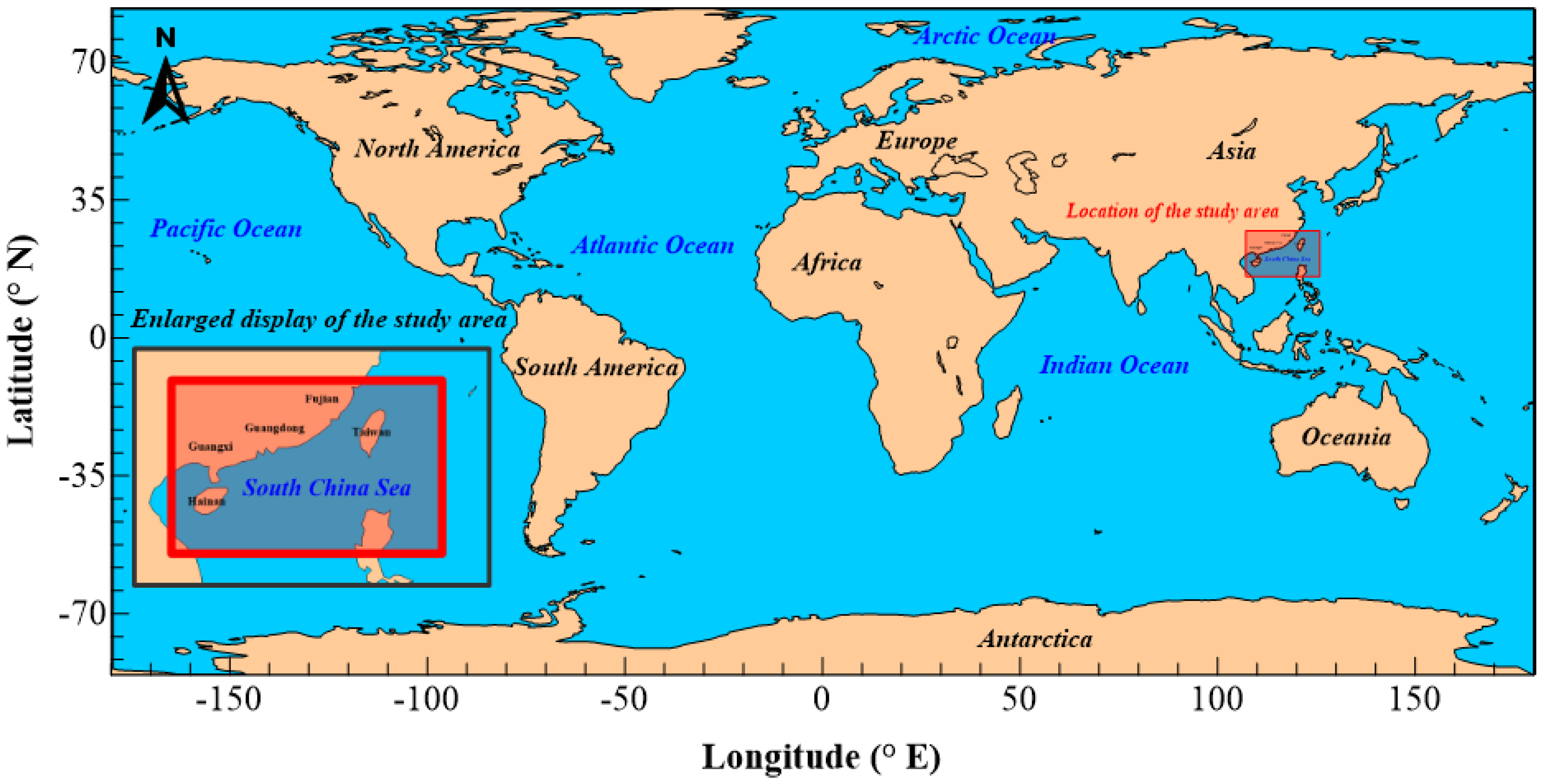
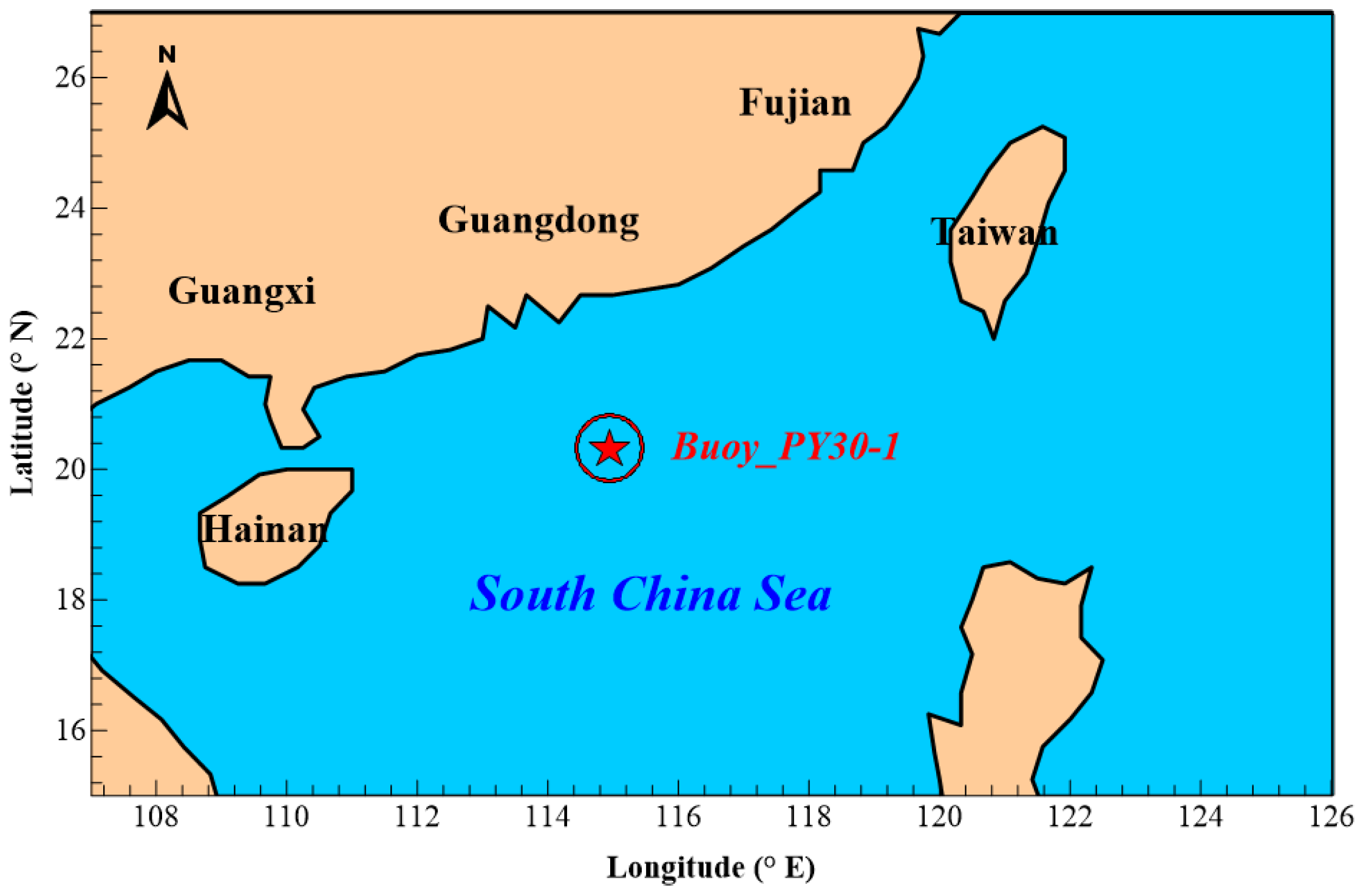
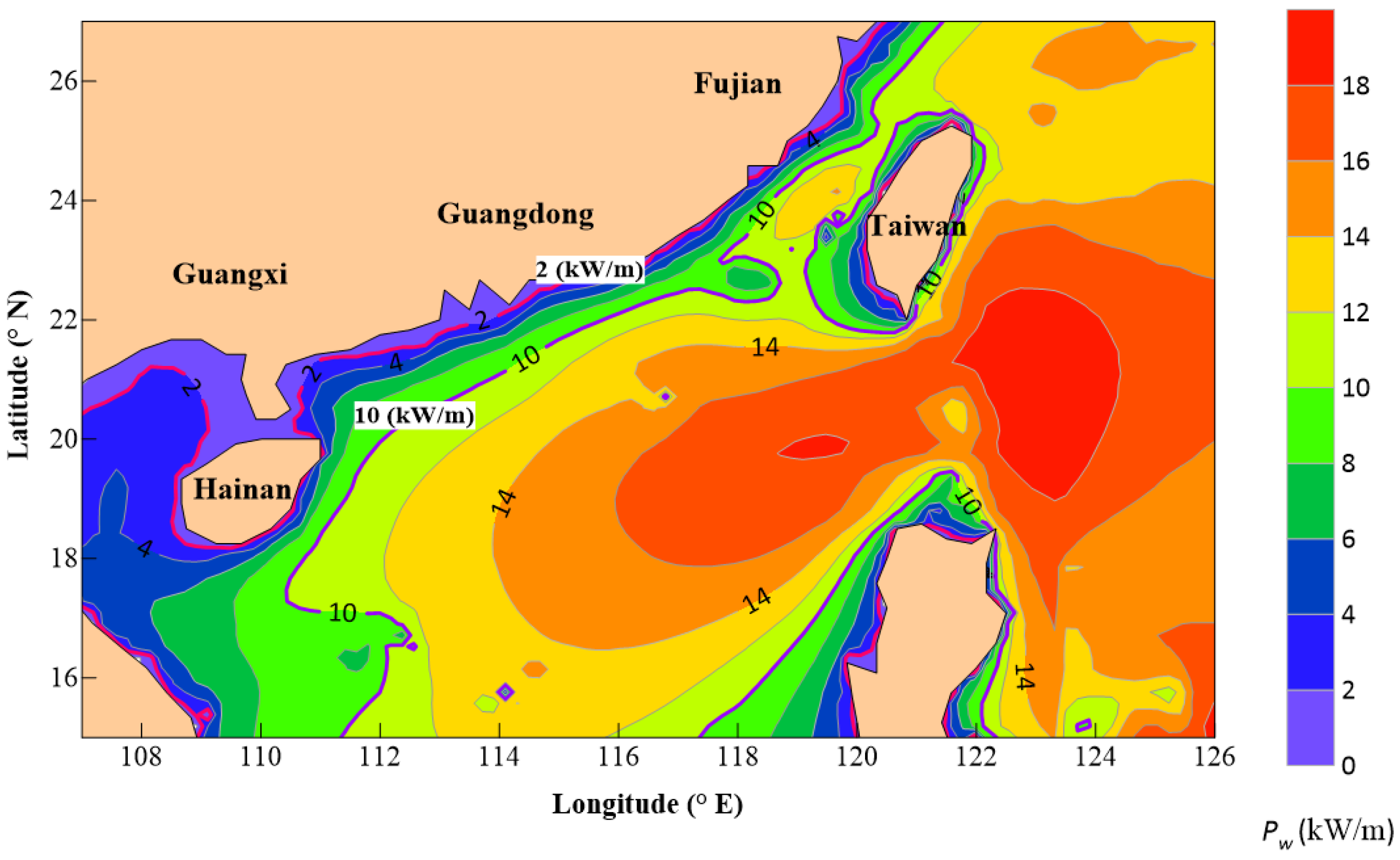
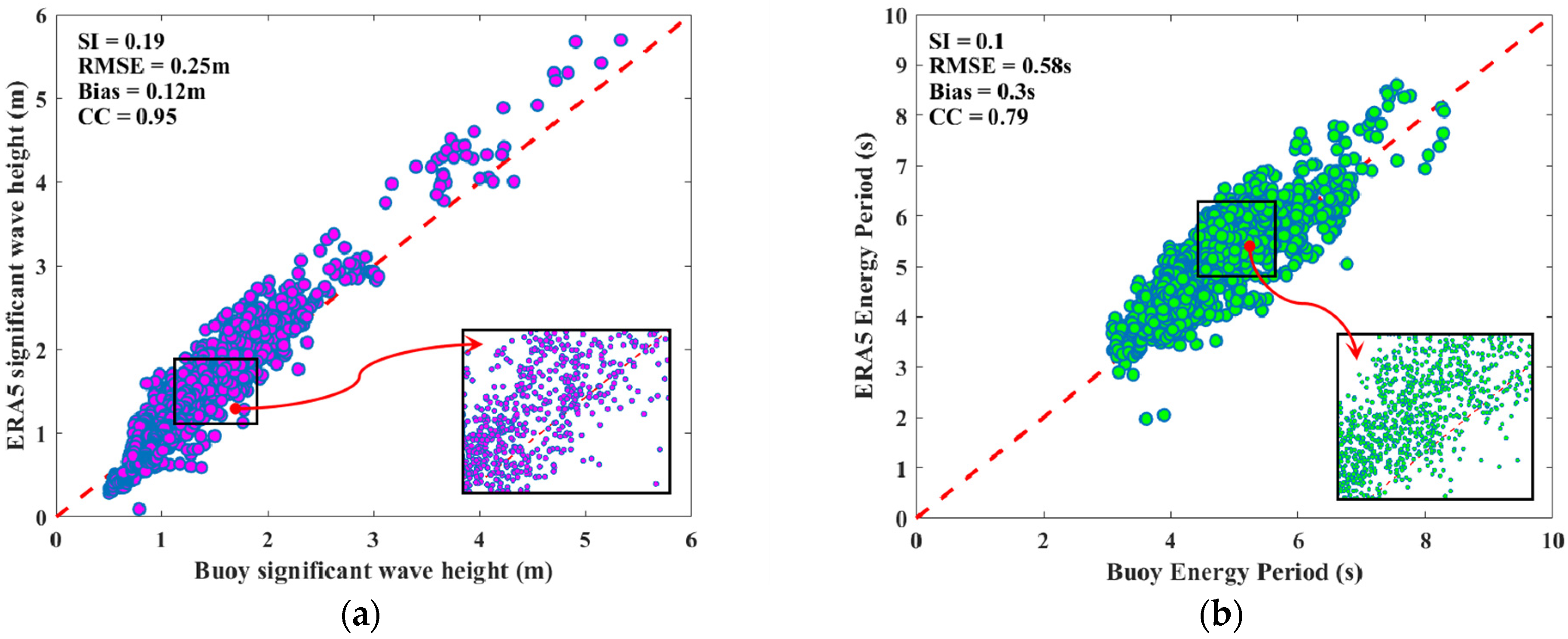
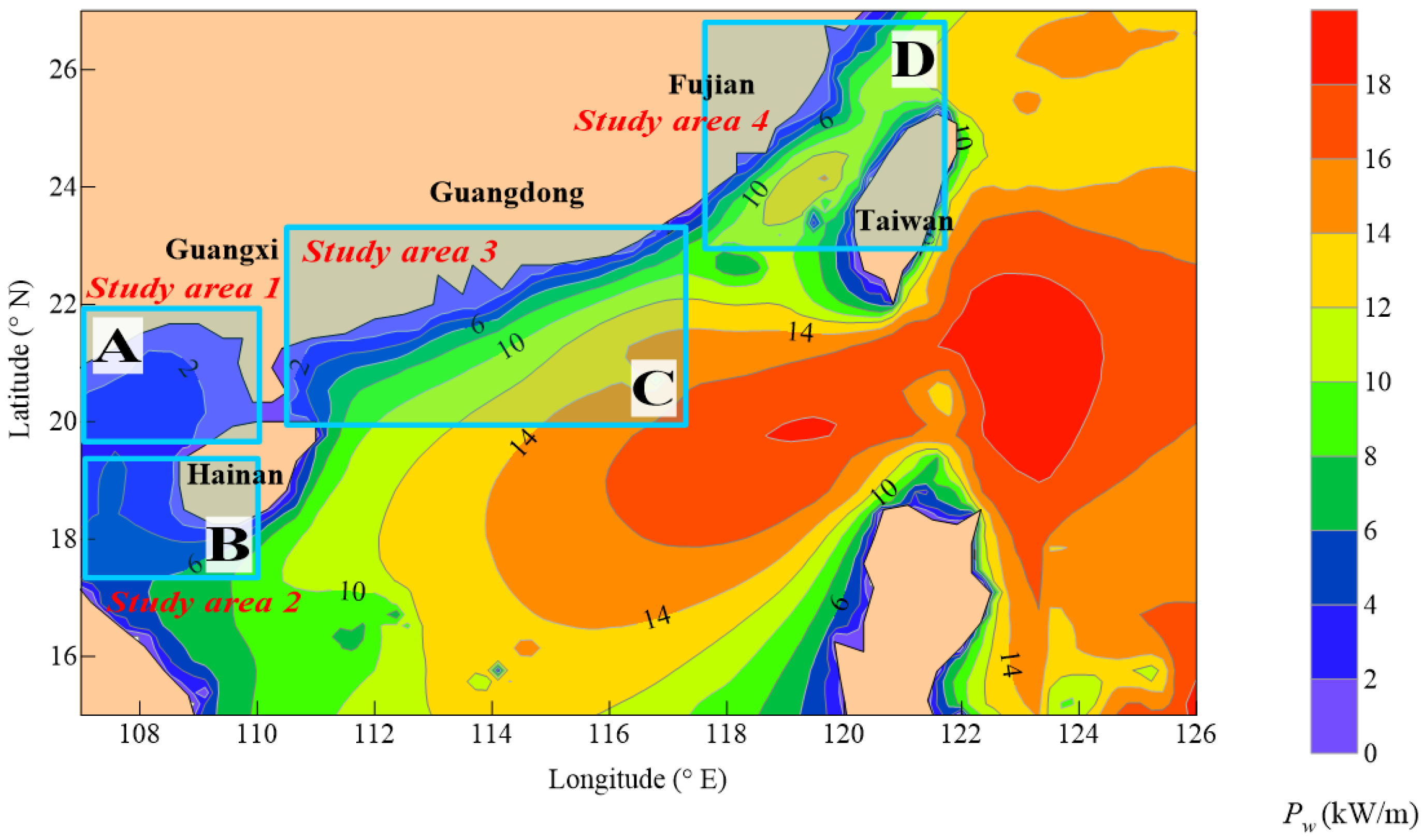

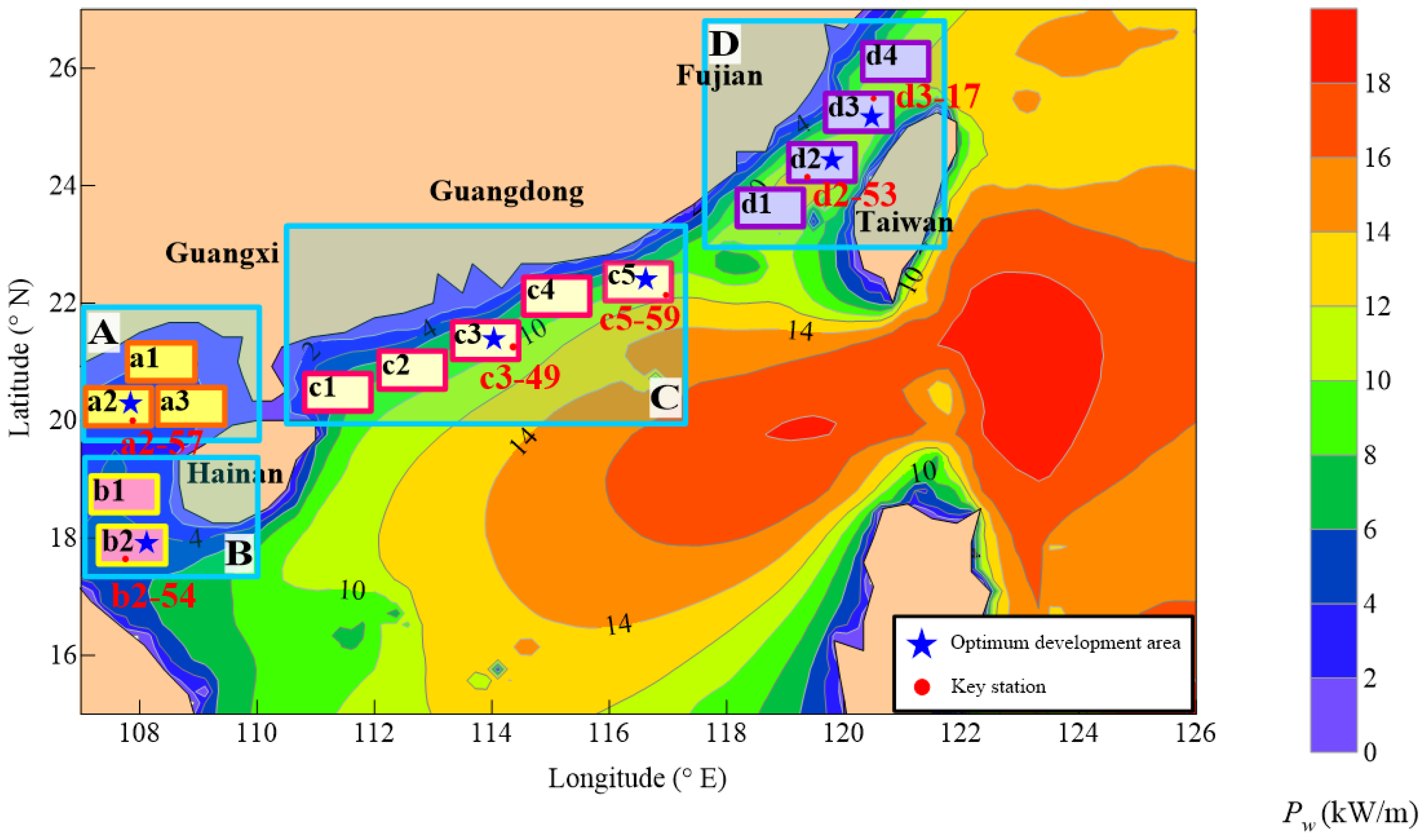
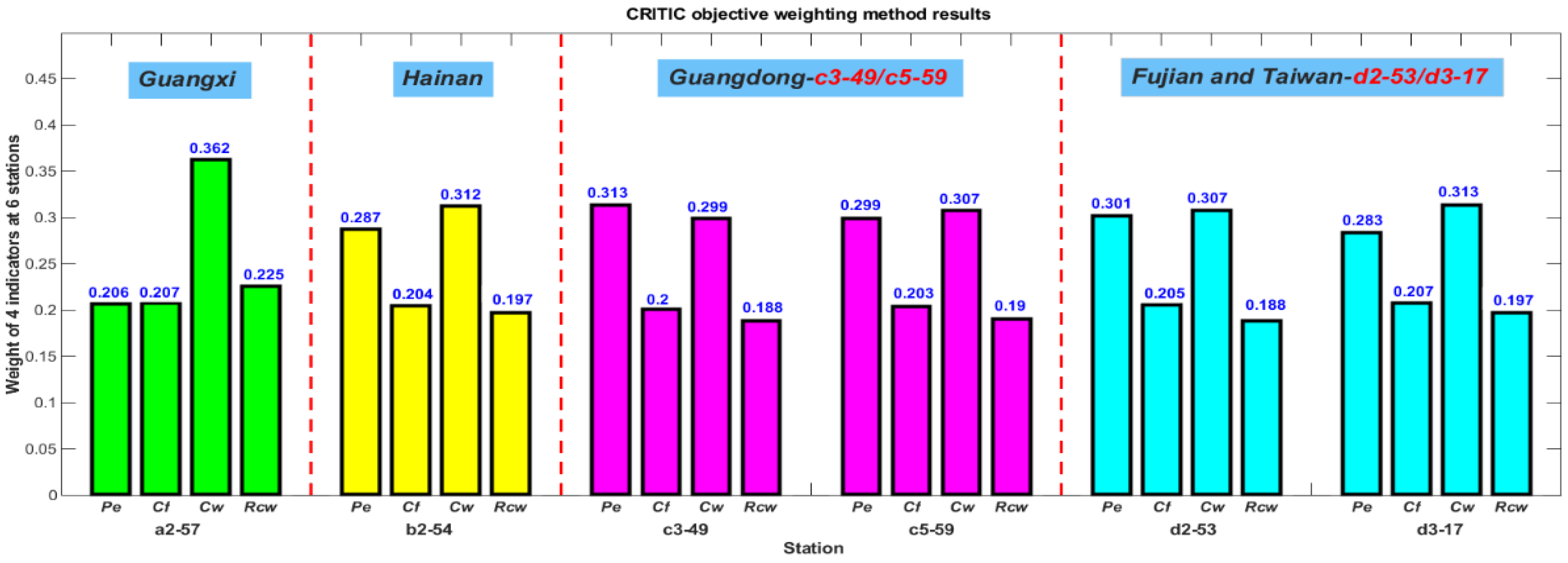
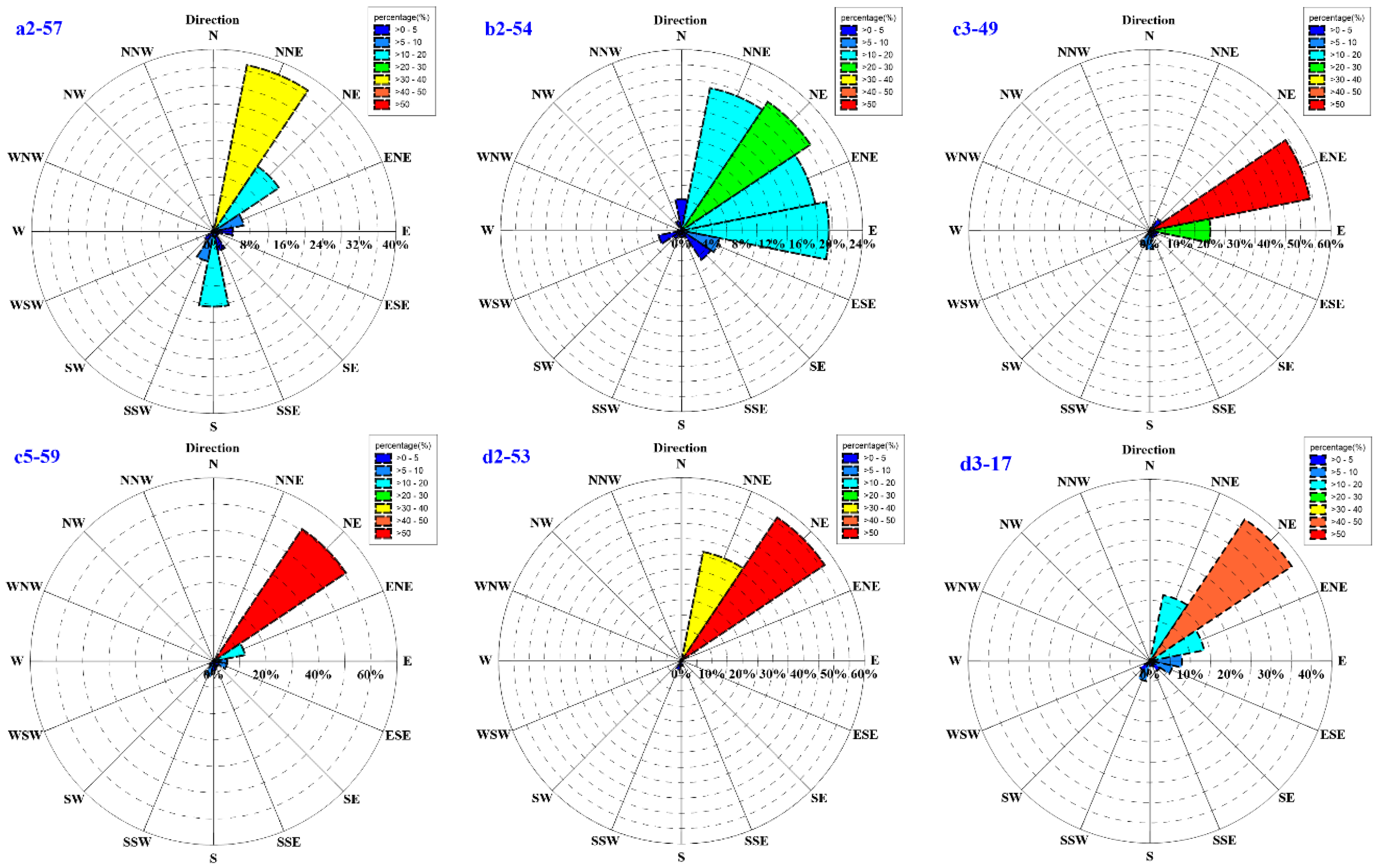
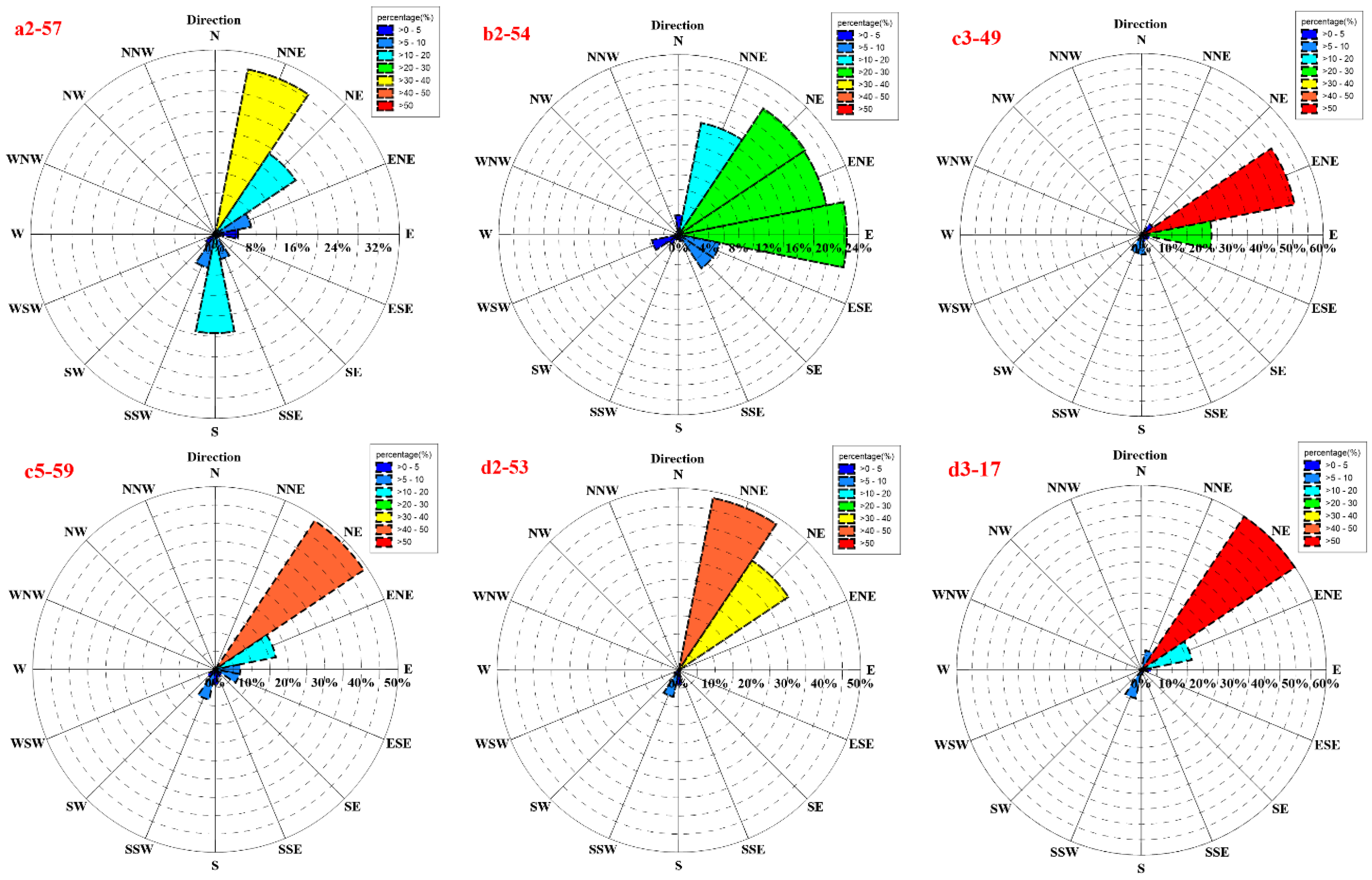
| Type | Device | Rated Power (kW) | Suitable Water Depth (m) |
|---|---|---|---|
| Wave-activated body | CECO | 500 | 30–50 |
| Oyster | 800 | ≈15 | |
| Wanshan | 100 | 20–100 | |
| Point absorber | AquaBuoy | 250 | 40–80 |
| Wavebob | 1000 | >50 | |
| AWS | 2000 | >50 | |
| Oscillating water column | WaveStar | 600 | 50–60 |
| OceanLinx | 200 | 5–50 | |
| Oscillating surge | RM5 | 360 | 50–100 |
| Overtopping | SSG | 150 | 6–18 |
| Wave Dragon | 40 | 20–40 |
| Index | h | Poor | Useable | Good |
|---|---|---|---|---|
| 0.93 | 1.05–1.98 | 1.99–2.91 | 2.92–3.84 | |
| 884.6 | 967.2–1851.8 | 1851.9–2736.4 | 2736.5–3621 | |
| 0.06 | 0.79–0.85 | 0.86–0.91 | 0.92–0.97 |
| Area | Level | Level | Level | |||
|---|---|---|---|---|---|---|
| a1 | 2.473 | Useable | 2532.573 | useable | 0.88 | Useable |
| a2 | 3.332 | Good | 3308.547 | good | 0.90 | Useable |
| a3 | 2.388 | Useable | 2332.867 | useable | 0.85 | Useable |
| Key Station | Index | AB | AWS | Wb | RM5 | Wanshan |
|---|---|---|---|---|---|---|
| a2-57 | 1.892 | 7.847 | 11.627 | 8.711 | 18.547 | |
| 0.008 | 0.004 | 0.012 | 0.087 | 0.052 | ||
| 0.492 | 2.042 | 3.026 | 2.267 | 4.827 | ||
| 2.462 | 1.418 | 11.638 | 9.446 | 10.726 | ||
| b2-54 | 6.172 | 23.905 | 21.837 | 15.597 | 26.783 | |
| 0.025 | 0.012 | 0.022 | 0.156 | 0.074 | ||
| 1.148 | 4.446 | 4.061 | 2.901 | 4.981 | ||
| 5.739 | 3.087 | 15.619 | 12.085 | 11.068 | ||
| c3-49 | 14.250 | 54.721 | 46.855 | 53.029 | 32.046 | |
| 0.057 | 0.027 | 0.047 | 0.147 | 0.321 | ||
| 1.370 | 5.262 | 4.506 | 5.100 | 3.082 | ||
| 6.852 | 3.655 | 17.331 | 11.333 | 12.841 | ||
| c5-59 | 15.196 | 56.465 | 51.445 | 60.525 | 34.222 | |
| 0.061 | 0.028 | 0.051 | 0.168 | 0.342 | ||
| 1.294 | 4.807 | 4.380 | 5.153 | 2.914 | ||
| 6.469 | 3.338 | 16.845 | 11.451 | 12.140 | ||
| d2-53 | 15.093 | 70.592 | 63.284 | 30.674 | 67.439 | |
| 0.060 | 0.035 | 0.063 | 0.307 | 0.187 | ||
| 1.080 | 5.051 | 4.528 | 2.195 | 4.826 | ||
| 5.400 | 3.508 | 17.417 | 9.146 | 10.724 | ||
| d3-17 | 12.707 | 48.293 | 45.688 | 56.039 | 30.427 | |
| 0.051 | 0.024 | 0.046 | 0.156 | 0.304 | ||
| 1.164 | 4.423 | 4.184 | 5.132 | 2.787 | ||
| 5.818 | 3.071 | 16.093 | 11.404 | 11.610 |
| Key Station | Predominating | Under Full Sea State (%) | Under Storm Protection (%) |
|---|---|---|---|
| a2-57 | (NNE-NE)+S | 71 | 76 |
| b2-54 | NE-E | 77.4 | 77.8 |
| c3-49 | ENE-E | 74.2 | 75.7 |
| c5-59 | NE-ENE | 60.7 (NE) | 66.4 (NE-ENE) |
| d2-53 | NNE-NE | 92.8 | 84.5 |
| d3-17 | NNE-ENE | 71.7 (NNE-ENE) | 77.2 (NE-ENE) |
| Key Station (WEC) | Under Full Sea State | Under Storm Protection | ||
|---|---|---|---|---|
| LCOE (EUR/MW h) | LCOE (EUR/MW h) | |||
| a2-57 (Wanshan) | 162583 | 1.3988 | 64828.9 | 3.5080 |
| b2-54 (Wanshan) | 234779.8 | 0.9686 | 200952.7 | 1.1317 |
| c3-49 (RM5) | 464852.2 | 1.7612 | 380657.4 | 2.1508 |
| c5-59 (RM5) | 530562.2 | 1.5431 | 367711. 8 | 2.2265 |
| d2-53 (Wanshan) | 591170.3 | 0.3847 | 254014.1 | 0.8953 |
| d3-17 (RM5) | 491237.9 | 1.6666 | 342505.2 | 2.3903 |
Disclaimer/Publisher’s Note: The statements, opinions and data contained in all publications are solely those of the individual author(s) and contributor(s) and not of MDPI and/or the editor(s). MDPI and/or the editor(s) disclaim responsibility for any injury to people or property resulting from any ideas, methods, instructions or products referred to in the content. |
© 2023 by the authors. Licensee MDPI, Basel, Switzerland. This article is an open access article distributed under the terms and conditions of the Creative Commons Attribution (CC BY) license (https://creativecommons.org/licenses/by/4.0/).
Share and Cite
Wan, Y.; Feng, X.; Zhang, W. Evaluating the Applicability of Mainstream Wave Energy Converters in the South China Sea. J. Mar. Sci. Eng. 2023, 11, 1198. https://doi.org/10.3390/jmse11061198
Wan Y, Feng X, Zhang W. Evaluating the Applicability of Mainstream Wave Energy Converters in the South China Sea. Journal of Marine Science and Engineering. 2023; 11(6):1198. https://doi.org/10.3390/jmse11061198
Chicago/Turabian StyleWan, Yong, Xiaoshun Feng, and Wen Zhang. 2023. "Evaluating the Applicability of Mainstream Wave Energy Converters in the South China Sea" Journal of Marine Science and Engineering 11, no. 6: 1198. https://doi.org/10.3390/jmse11061198
APA StyleWan, Y., Feng, X., & Zhang, W. (2023). Evaluating the Applicability of Mainstream Wave Energy Converters in the South China Sea. Journal of Marine Science and Engineering, 11(6), 1198. https://doi.org/10.3390/jmse11061198









